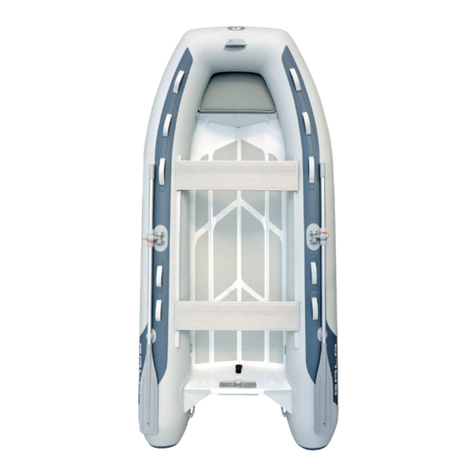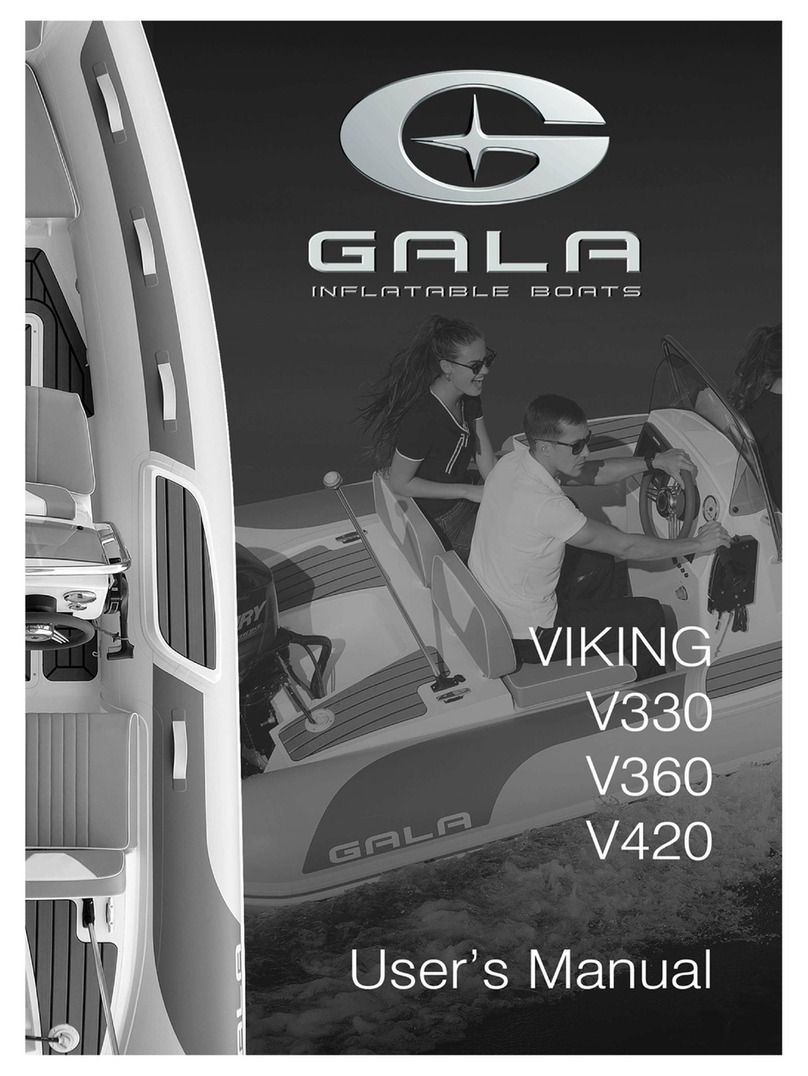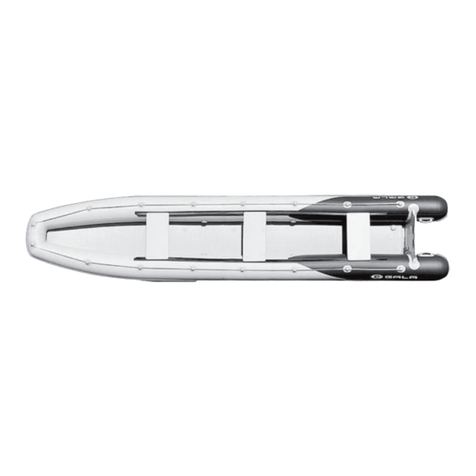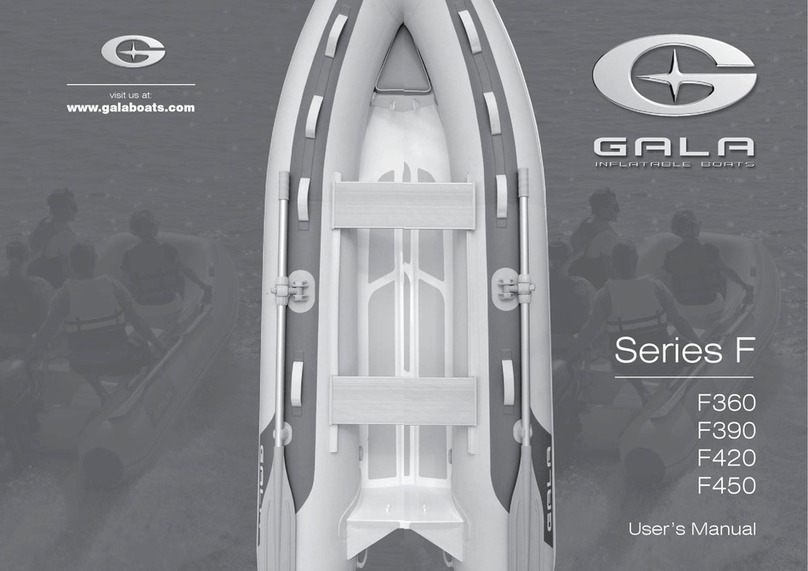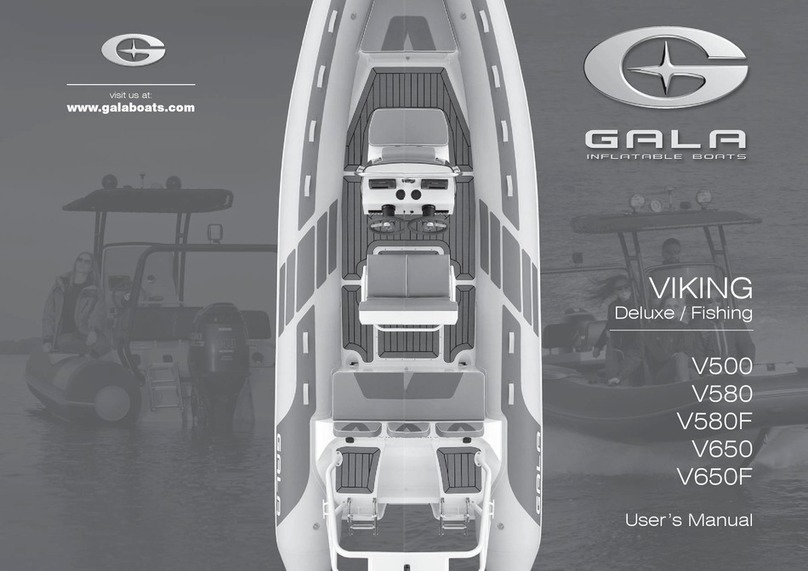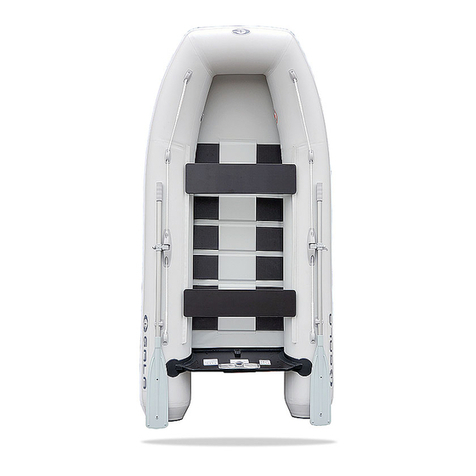
15. MAINTENANCE
a) Cleaning:
xClean your boat often, and obligatory before winterizing.
xFor cleaning use SOAP AND FRESH WATER ONLY!
xAt all times keep the inflatable tube, vinyl and other boat parts
free of any chemical ingredients like:
oGasoline, grease, oil and any other oily product.
oSuntan oils, lotions and any other body care products,
oPollution ingredients, dirt and dust,
oSilicon based products, automotive chemical products
xClean and rinse the boat or its part as soon as possible once
you find these ingredients on your boat to prevent the damage.
xKeep your boat properly covered all the time you do not use it.
xKeep your boat away of or well protected against car or other
exhaust smoke or pollution, which may damage the boat.
CAUTION
1. NEVER USE ANY OTHER THAN SPECIFIED
CHEMICALS, CLEANING LIQUIDS OR AGENTS, TO
AVOID DAMAGE OF YOUR BOAT.
2. NEVER USE HIGH PRESSURE CLEANING
EQUIPMENT TO AVOID DAMAGE OF THE BOAT.
b) Air tightness of inflatable tube:
xAs the inflatable tube is a main safety feature - check airtightness of
your boat regularly. Inspect the condition of all inflatable compartments
with soap foam, and make sure that:
othere is no material cracks, holes and leaks,
oall inflation valves and seams are intact.
xISO 6185 standard permits a certain amount of pressure loss - 30%:
45 mbar (0.63 psi) per 24 hours for the buoyancy tube, what is stated
as acceptable. This requirement is applicable only for main flotation
volumes – inflatable tube, and not to inflatable seats, keels, floors and
other inflatable parts.
xOnce you discover the pressure decrease – just add some air by foot
pump. Never use high-pressure inflators to inflate the boat.
xTemperature has a great influence on air pressure. A variation of 1°C
results in a variation in the same way of about +/- 4 mb (0,06 psi).
xIf you discover sufficient pressure drop, but do not see actual leakage:
oStep 1: check the inflation/deflation valves and overpressure
valves (if there is one),
oStep 2: check the major seams,
oStep 3: check the tube material from the top to the bottom.
Contact your Dealer for advice if necessary.
xEvery discovered source of leakage must me properly repaired. Do not
operate leaking boat.
13. IN CASE OF ACCIDENT
In case of accident:
xDo not panic and reassure passengers.
xBe aware that your boat, even damaged, is often the best shelter and
facilitates your rescue. Never leave the boat it floats, as the inflatable
boat is practically unsinkable, even full of water.
xIf, after an accident, a compartment deflates, bring it inside the boat,
restore the load balance to the opposite side of the deflated
compartment and return at reduced speed.
xIn case of a collision or an impact with a floating object, stop to
examine the hull, the buoyancy tubes, the motor and its attachments
and return to shore at a low speed.
xTake your boat to your Dealer for inspection before using it again.
WARNING
NEGLECTING INSPECTIONS AND REPAIRS MAY LEAD
TO A SERIOUS INJURY, BOAT DAMAGE AND WILL
REDUCE THE LIFE OF YOUR BOAT.
14. ENVIRONMENT
RESPONSIBLE BOATING BEGINS WITH YOU!
Respect your environment by applying the following basic safety rules:
xAVOID CREATING EXCESSIVE WASH.
xKEEP OUT OF DESIGNATED SWIMMING AREAS.
xRESPECT ALL ANIMAL LIFE.
xBE CAREFUL NOT TO OVERFILL THE FUEL TANK.
xDON'T MAKE UNNECESSARY NOISE.
xDO NOT DISCHARGE OIL OR FUELS INTO THE WATER.
xDO NOT LITTER.
xDONT MAKE EXCESSIVE WAKE.
The health of your environment depends on us all acting responsibly to
ensure a clean tomorrow. If each of us follows these few simple rules, we
can help to keep the Earth's resources intact for future generations.
- 14 - - 15 -






